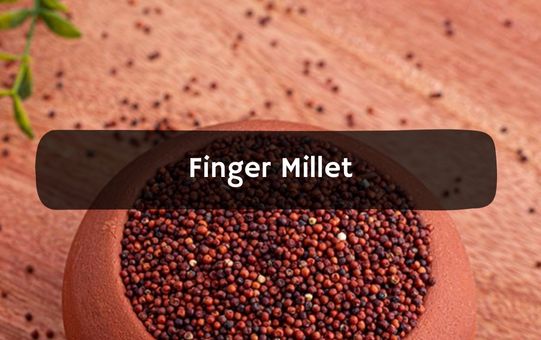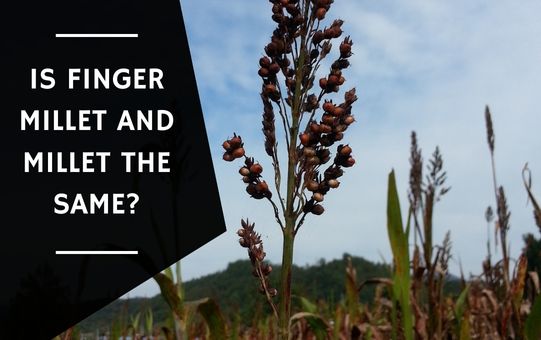The majority of people believe that millet and finger millet are the same things, but the question Is finger millet and millet the same? is asked frequently. Let’s delve into the response below!
No, finger millet is distinct from millet. Finger millet is a healthier alternative to millet due to its higher protein and fiber content.
This is a fun post for millet enthusiasts who want to know whether millet and millet are identical.
Contents
- What is Finger Millet?
- What is Millet?
- How are they used differently?
- Are there any nutritional differences?
- Can they be used interchangeably in recipes?
- The Difference Between Finger Millet and Millet
- Why is Finger Millet Important?
- How to Cook Finger Millet?
- Health Benefits of Finger Millet
- Potential Risks of Eating Finger Millet
- Bottom Line
What is Finger Millet?
In many regions of Africa and Asia, finger millet, also known as ragi or nachni, is a staple food. Small and round, this grain is rich in protein, iron, and calcium. Additionally, it is gluten-free, making it an excellent option for those with gluten intolerance.
In Africa and India, finger millet is frequently used to make porridge or flatbread, as well as beer.
Read Also: Is It Good To Have Millet At Night?
What is Millet?
In contrast, millet is a group of grasses with small seeds that includes pearl millet, foxtail millet, proso millet, and finger millet. It is an ancient grain that has been cultivated in Asia and Africa for thousands of years.
In addition to being gluten-free, it is high in protein, fiber, and minerals. Millet is a common cereal grain that can also be ground into flour for use in baking.
How are they used differently?
While finger millet and millet can be used similarly, there are significant differences in their traditional applications.
In Africa and India, finger millet is commonly used to make porridge, whereas millet is typically used as a cereal grain or in baking. In India, finger millet is also used to make roti, a type of flatbread that is not traditionally made with millet.
In Africa and Asia, finger millet is also used to make beer, whereas millet is not typically employed for this purpose.
Are there any nutritional differences?
Both finger millet and millet are nutrient-rich grains, but finger millet is especially rich in calcium and iron.
Additionally, finger millet is rich in amino acids, vitamins, and minerals. Additionally, millet is rich in protein, fiber, and minerals such as potassium, magnesium, and phosphorus.
| Nutrient | Finger Millet | Millet |
|---|---|---|
| Protein | 11% | 9% |
| Fiber | 3.5g | 2g |
| Calcium | 34mg | 31mg |
| Iron | 2.7mg | 2.2mg |
| Vitamin B3 | 1.5mg | 1.1mg |
Note: The nutritional value of a crop can vary depending on its specific variety and growing conditions. This comparison between the two types of millet is merely general.
Can they be used interchangeably in recipes?
While finger millet and millet can be utilized similarly, they cannot always be substituted in recipes. Finger millet has a distinct flavor and texture that is difficult to replicate with millet.
Additionally, distinct millet varieties may have distinct flavors and textures. It is best to use the grain specified in a recipe or to experiment with various grains to determine the optimal substitute.
The Difference Between Finger Millet and Millet
Regarding ancient grains, finger millet and millet are frequently grouped together. But are they actually identical? The brief response is no. Although they are both millets, they are two distinct grains with distinct characteristics and applications.
| Finger Millet | Millet |
|---|---|
| Also known as ragi or nachni | Group of small-seeded grasses that includes pearl millet, foxtail millet, proso millet, and finger millet |
| High in protein, iron, and calcium | High in protein, fiber, and minerals |
| Gluten-free | Gluten-free |
| Commonly used to make porridge and flatbreads, and to make beer | Commonly used as a cereal grain and in baking |
| Unique taste and texture | Different types have distinct tastes and texture |
Why is Finger Millet Important?
Finger millet, also known as ragi and nachni, is an essential grain for a number of reasons. Here are several crucial reasons why finger millet is essential:
Nutritional value
Finger millet is rich in protein, iron, and calcium, making it an excellent choice for those seeking to increase their consumption of these vital nutrients. Additionally, it is gluten-free, making it an excellent option for those with gluten sensitivities.
Climate resilience
Finger millet is a resilient crop that can thrive in a variety of environments. It is resistant to drought and can grow in poor soil, making it an excellent option for farmers in regions with erratic climates or limited resources.
Food security
In many regions of Africa and Asia, finger millet serves as a reliable food source for millions of people. It is a crucial crop for food security in these regions due to its resiliency and adaptability to a wide range of environmental conditions.
Cultural significance
For thousands of years, finger millet has been a staple food in many cultures, and it holds significant cultural significance in many communities. It is utilized in the preparation of traditional foods such as porridge, roti, and beer.
Potential Health benefits
Finger millet is beneficial for diabetics due to its low glycemic index. It is also rich in dietary fiber, which aids in preventing constipation. It is also beneficial for heart health due to its high magnesium content, which helps reduce hypertension and the risk of cardiovascular disease.
How to Cook Finger Millet?
Finger millet, also referred to as ragi or nachni, is a versatile grain that can be prepared in numerous ways. Here are some popular cooking methods for finger millet:
Ragi Porridge
In Africa and India, this is the traditional method for cooking finger millet. Rinse 1 cup of finger millet and combine it with 2 cups of water in a saucepan to make ragi porridge.
Reduce the heat after bringing the mixture to a boil. Simmer for approximately 15 to 20 minutes, or until the finger millet has completely absorbed the water and has a creamy consistency. Add sugar or honey to taste, then warm the dish.
Roti
In India, finger millet flour is commonly used to make roti, a type of flatbread. To prepare roti, mix together 1 cup of finger millet flour and water to form a dough. Roll out the dough into small circles, then cook them on a hot griddle or skillet until both sides are lightly browned.
Finger Millet Idli
Finger Millet Flour can also be used to make Idli, a nutritious and delicious steamed dish. Mix 1 cup of finger millet flour, 1/2 cup of rice flour, and 1/4 cup of urad dal flour to make Finger Millet Idli.
Add water and salt as necessary and ferment for eight hours. The mixture is then poured into idli molds and steamed for 20 minutes.
Finger Millet upma
Additionally, Finger Millet can be used to prepare the traditional South Indian dish known as upma. To prepare finger millet upma, lightly toast finger millet in a pan until golden.
Incorporate water and bring it to a boil. Then, according to taste, add vegetables, salt, and spices. Cook finger millet until tender and the water has been absorbed.
Finger Millet Bhel
Finger millet can also be used to prepare bhel, a popular Indian snack. To make finger millet bhel, fry finger millet until golden brown. Mix with additional components such as tomatoes, onions, and chutneys.
These are a few popular methods for preparing finger millet, but there are many others, depending on personal preference. Experiment with various recipes and seasonings to find your preferred method of preparing this wholesome grain.

Health Benefits of Finger Millet
Finger millet, also known as ragi or nachni, is a nutritious grain that is rich in calcium, iron, and protein.
It has also been shown to help reduce blood sugar levels, enhance digestion, and promote weight loss.
In addition, finger millet is gluten-free, making it a suitable alternative for individuals with gluten intolerance. Finger millet is an excellent addition to a healthy diet.
Potential Risks of Eating Finger Millet
While finger millet is a nutrient-dense food with numerous health benefits, there are some potential dangers to be aware of before consuming it.
Finger millet is rich in phytates, which can inhibit the absorption of minerals like iron, zinc, and calcium. Prior to consumption, soaking, fermenting, or sprouting the grain can reduce phytate levels and increase mineral absorption.
High consumption of finger millet may also increase the likelihood of developing kidney stones. This is because the grain contains high levels of oxalates, which can crystallize and contribute to the formation of kidney stones.
Additionally, some individuals may be allergic to finger millet, which can cause symptoms such as itching, hives, and breathing difficulties. If you have an allergy to other grains, you should avoid finger millet.
Before making significant changes to your diet, you should always consult your doctor or a nutritionist, especially if you have a medical condition or are pregnant.
Read Also: How Often Can You Eat Millet?
Bottom Line
Finger millet and millet may appear similar, but they are in fact two distinct grains with distinct properties and applications.
Finger millet is rich in calcium and iron and is traditionally used to make porridge and flatbreads, whereas millet is a group of grains that is frequently used as a cereal grain and in baking.
Due to their distinct flavor and texture, they are not always interchangeable in recipes, even though they can be used in similar ways.
What is the difference between millet and finger millet?
Millet and finger millet are both types of grains, but they come from different plant species.
Millet refers to a group of small-seeded grasses that are cultivated as cereal crops for human and animal consumption. There are several different species of millet, including pearl millet, proso millet, foxtail millet, and finger millet.
Finger millet, also known as African millet or Ragi, is a type of millet that is cultivated in Africa and Asia. It is a staple food in many parts of Africa and India, and is known for its high nutritional content, particularly its high calcium content. Finger millet has small, finger-like grains that are reddish-brown in color.
is finger millet healthy?
Yes, finger millet is healthy. It is a good source of fiber, protein, calcium, and other essential nutrients. It also has a low glycemic index, making it a good choice for people with diabetes.

